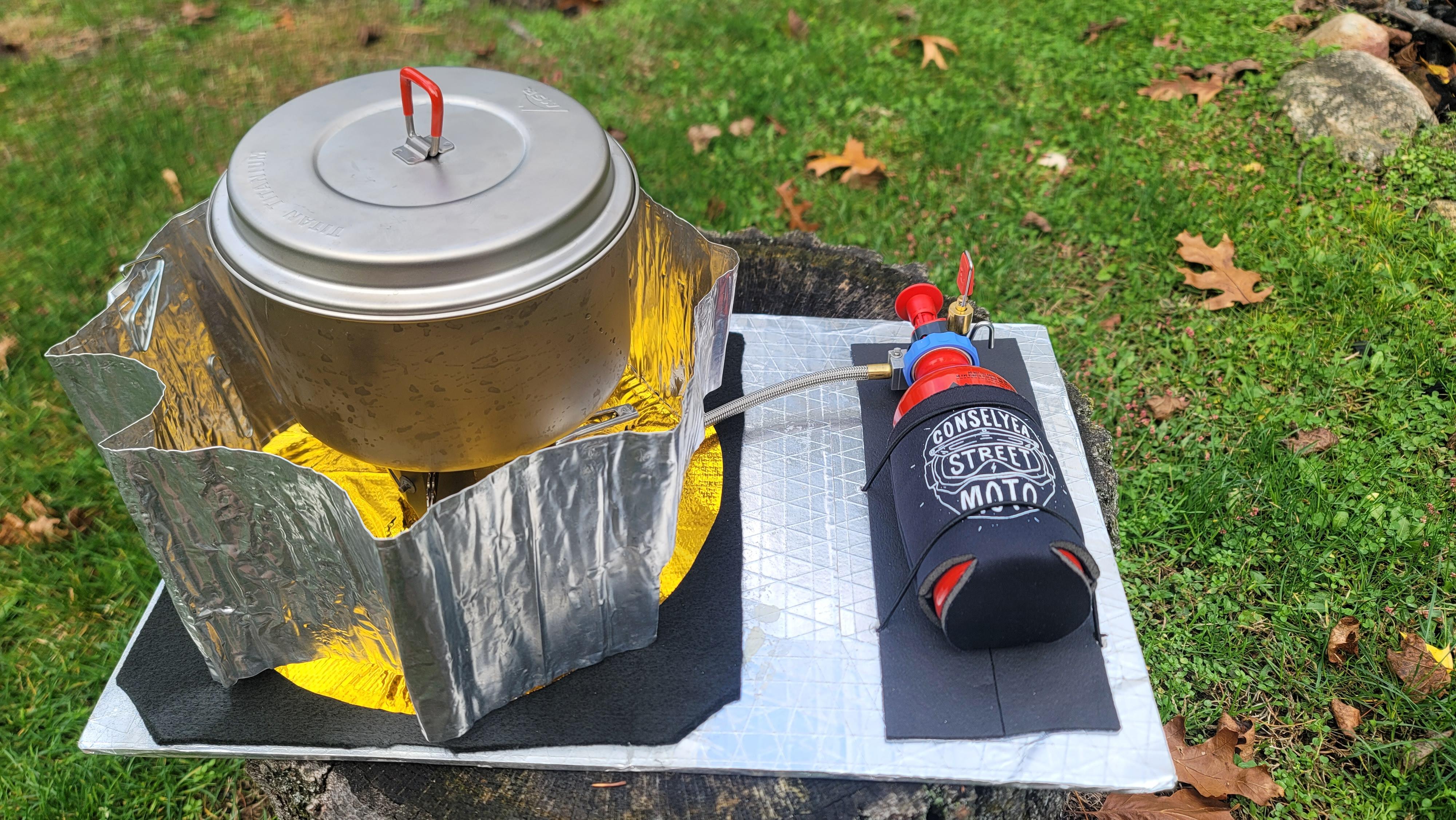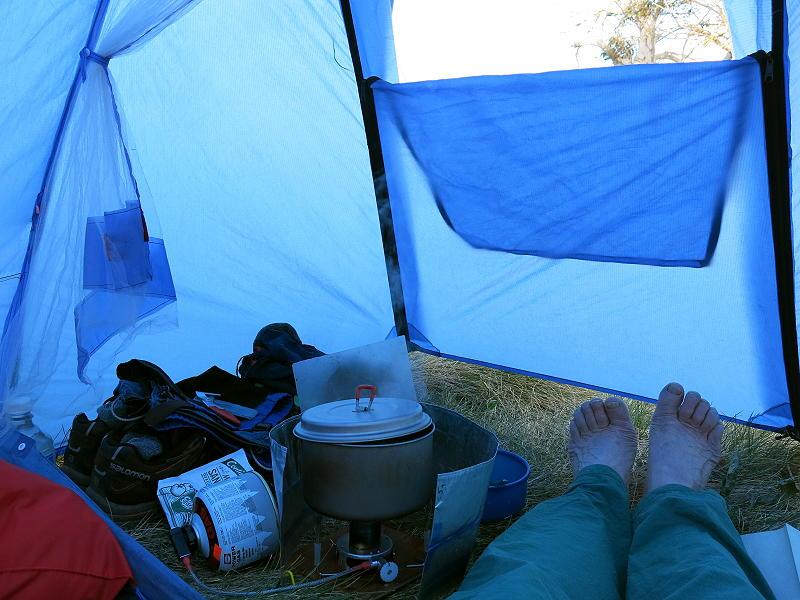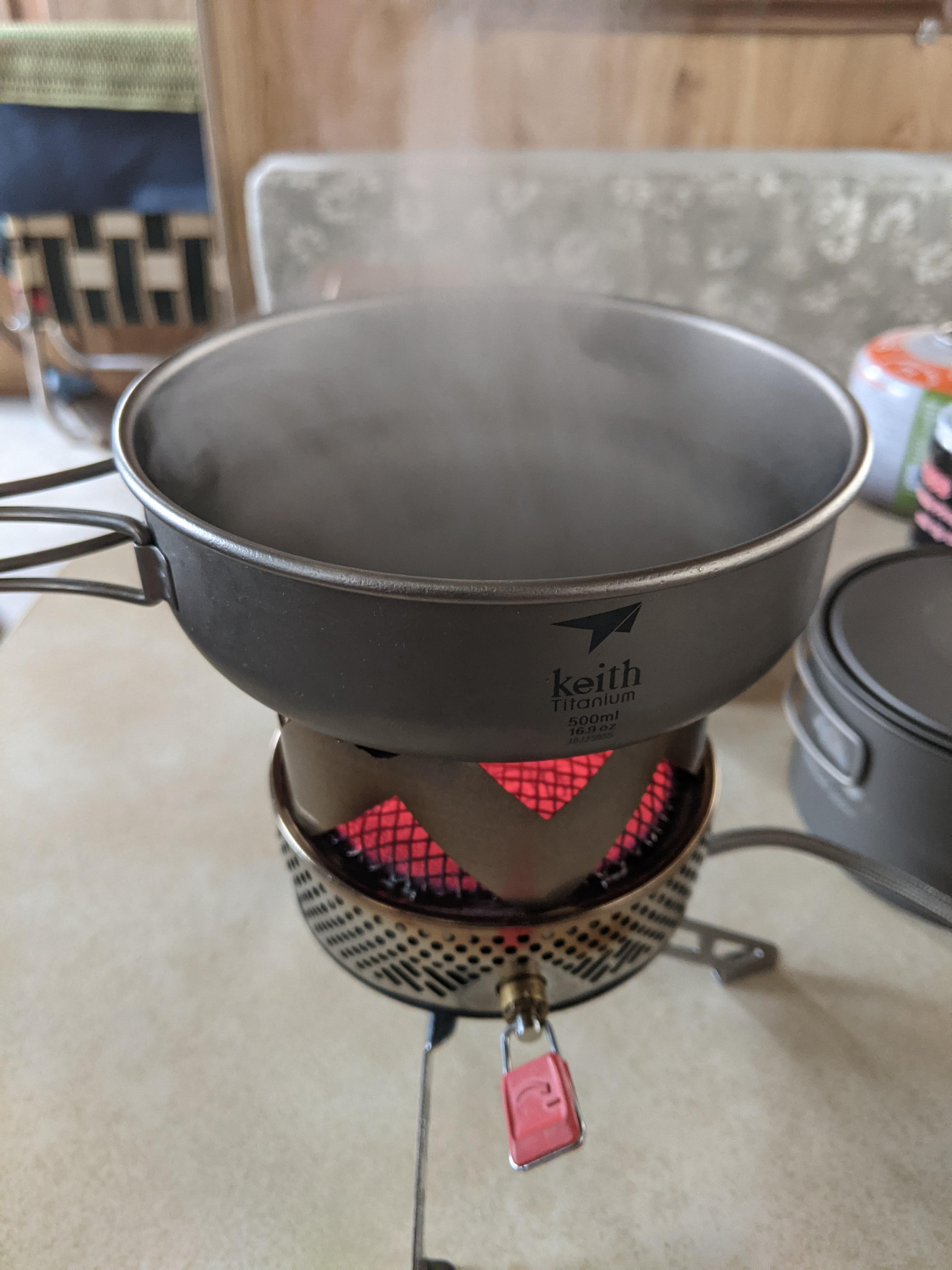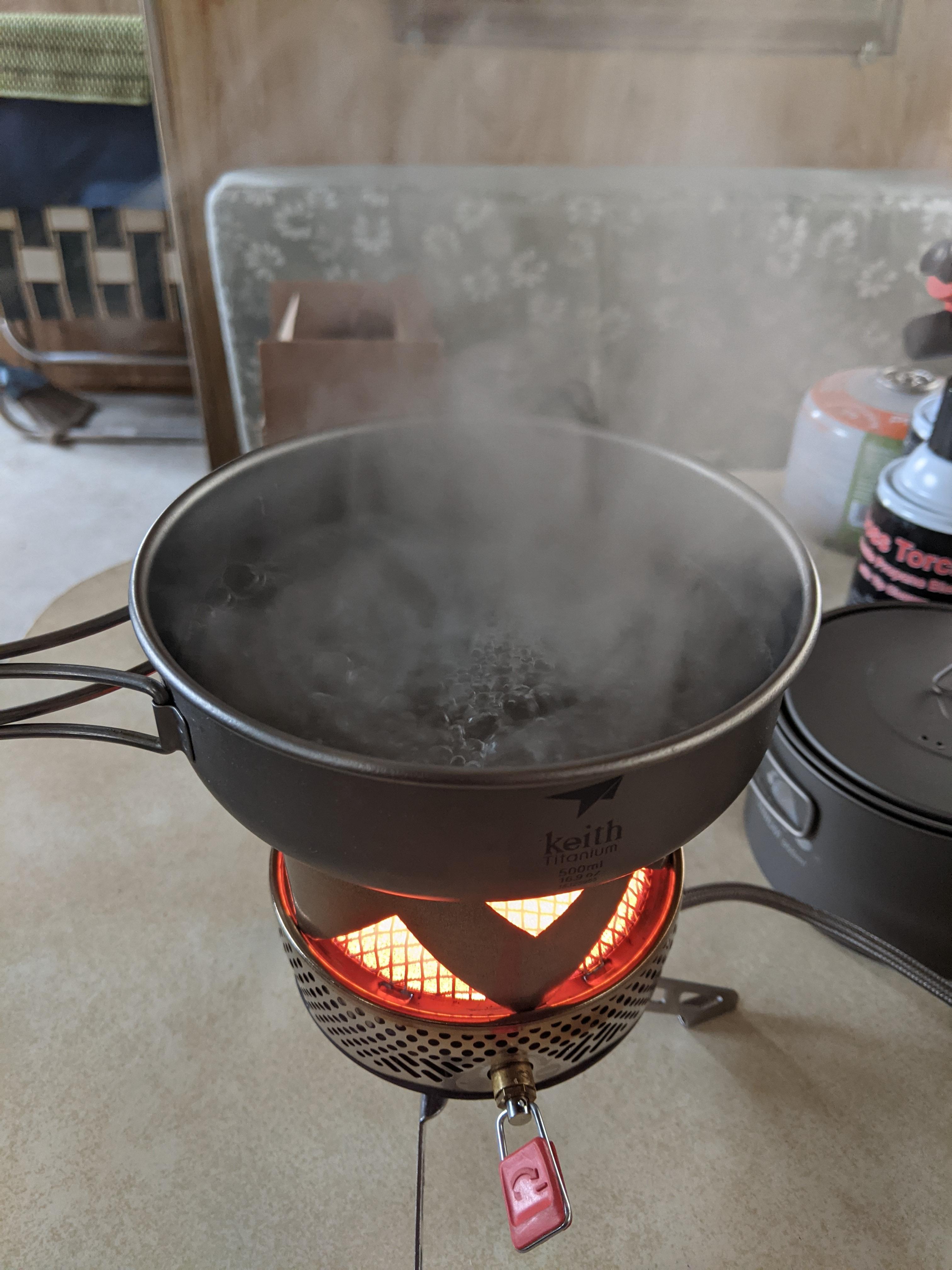Topic
Cooking Safer Inside Tents
Forum Posting
A Membership is required to post in the forums. Login or become a member to post in the member forums!
Home › Forums › General Forums › Philosophy & Technique › Cooking Safer Inside Tents
- This topic has 40 replies, 13 voices, and was last updated 2 years, 1 month ago by
 DriCamp.
DriCamp.
-
AuthorPosts
-
Nov 18, 2022 at 1:41 am #3765514
It’s beginning to look a lot like winter in the northern latitudes. Time to review how to cook safer inside most lightweight backpacking tents.
Use this advice at your own risk.
In brief, from safest to least safe:
1. Don’t. Cook elsewhere.
2. Everything else.
Done. Thanks for reading.Well, maybe not. So here are detailed guidelines for daredevils.
Unwanted fire: Roaring, sparking, wood bonfires are right out. Alcohol, gasoline, kerosene, and similar liquid fuels all invite ignition of spilled fuel. Canister fuels risk explosion from leaking canisters, loose stove connections, or valves left open. Solid fuels like ESBIT are nearly idiot proof, though idiots are evolving rapidly – somehow.
Stove stability: “More stable are better” bumper stickers shall be issued – if you want to avoid burns from stove flames and spilled boiling water. Tall, tippy canister stoves are not nearly as stable as remote canister stoves. Most alcohol stoves are too tippy, too. Liquid fuel stoves are usually very steady. Cone stoves like several Trail Designs, uh, designs, are incredibly stable.
Flare ups: Liquid-fuel stoves that require priming or preheating run the risk of unexpected balls of fire. Canister stoves sometimes produce spherical blazes if you do something stupid. So don’t be stupid. While I’ve never seen ESBIT flare up, someone will tell me I’m wrong.
Toxicity: All common fuels are toxic. Least toxic are canister fuels, unless you are huffing them, when that’s a feature, not a bug. Non-denatured ethanol is reasonably safe – just don’t drink and drive a tent stake. I hope it’s obvious that gasoline, kerosene, isopropyl alcohol, and denatured alcohol are bad for you. While I don’t recall any package warnings about eating ESBIT, it’s still a really bad idea. The smell of burning ESBIT in the morning makes some people nauseous, instead of smelling like – victory. All burning fuels can generate carbon monoxide, which leads to the next topics.
Ventilation: This helps remove carbon monoxide and other toxic vapors, humidity from heated food and water that will condense inside, and lingering food smells that attract starving thru-hikers and other varmints. Best if you cook in a vestibule with the door open; next best inside the tent with a door open and all upper vents open; and least good, inside a closed tent with upper and lower ventilation. Avoid cooking in a tightly buttoned-up or snowed-in tent. Tarp fans, hammock hangers, and cowboy campers are in good shape.
Flame color: Yellow fires generate more carbon monoxide, and ESBIT and most alcohol stove flames are quite lemony. All other fuels depend on stove design and pot diameter, so no sweeping generalizations, except: strive for blue flames when a pot is on top.
Recommendations: If you must cook inside a tent, then your best bet might be:
- Cook in the vestibule with the door open, or open up lots of top and bottom ventilation
- Use a remote canister stove, with the flames reduced until mostly blue
Let the flame wars begin.
— Rex
PS – There’s always electric cooking :-)
Nov 18, 2022 at 3:51 am #3765517yeah, agreed.
a remote canister stove is generally the safest overall. No chance of spilling liquid fuel, and its pretty rare to get much of a flare up when first lit, and generally burn pretty clean and controllable. A tall one is a good bit more unstable, but if it has a stand/legs for the bottom and even better if the pot locks on (jetboil, MSR etc) then it’s still not too bad.
If you must have a liquid fuel stove (a whisperlite or nova etc) then connect it up and light it outside, as they are prone to a bit of a fireball when first getting going. If you really need to cook inside then move it in carefully move it inside once it’s settled down and burning steadily, they’re much more predictable at that point.
And yes, ventilation is key, both for any gasses produced, and for all the steam produced by the cooking.
Nov 18, 2022 at 6:05 am #3765520 this is where my little set up will come in handy. It is portable where i can light her up outside then move it wherever needed, while remaining altogether and lite, no hassle. Although I will probably just be using my Windburner or Windmaster on most winter trips..Nov 18, 2022 at 7:50 am #3765527
this is where my little set up will come in handy. It is portable where i can light her up outside then move it wherever needed, while remaining altogether and lite, no hassle. Although I will probably just be using my Windburner or Windmaster on most winter trips..Nov 18, 2022 at 7:50 am #3765527Bears should be considered. Here on the west coast of BC, bears don’t hibernate as long — typically just from December to March.
And as Stephen Herrero recommends (link, blue box), if cooking in a tent, four-season campers should use two different tents (and sleeping bags I would say). “He dedicates one shelter for three-season use, and never contaminates it with food smells”.
Nov 18, 2022 at 4:46 pm #3765608Note that MSR is adamant about not using any Windburner or Reactor stove inside a tent due to carbon monoxide emissions.
Based on Roger Caffin’s 2008 Reactor tests, I would agree.
The Soto Windmaster might be better choice for tent interiors, if you add canister legs, or are careful to not tip it over.
— Rex
Nov 18, 2022 at 8:18 pm #3765612re Upright canister stoves, inside tents:
Well, Sue & I have spent a couple of 2-month long trips across the Pyrenees cooking inside our tent all the time. To make matters ‘worse’, we were using those tall 450 g gas canisters, under a Snow Peak GST-100 upright stove. Sure, the combination was a bit tall – so I made sure every time that the canister was well grounded and vertical. We had many fine meals and zero accidents.
(Why the 450 g canisters?: usually they were all we could find in little mountain village shops.)The moral here? A careful walker need have no fears. The accidents will gravitate to the idiots, even if they are evolving!
Cheers
Nov 18, 2022 at 10:47 pm #3765614One more pro tip: Don’t put your face right next to any stove as you are starting it up.
Besides risking undesired beard burns, you could breathe in a variety of nasty chemicals, including carbon monoxide, no matter how good the ventilation.
This advice triggered by very recent experience diagnosing and repairing yellow-flamed propane wall heaters.
“Gosh, why am I a little dizzy?” The obvious answer didn’t occur to me until a couple of hours later, after the CO cleared from my system.
— Rex
Nov 18, 2022 at 10:55 pm #3765615If a canister stove has yellow flames, TURN IT OFF.
It may have a blocked jet; for sure it does not have enough oxygen.Cheers
Nov 19, 2022 at 11:57 am #3765641The accidents will gravitate to the idiots, even if they are evolving!
Some of us are just clumsy.
Nov 19, 2022 at 4:05 pm #3765668Nov 18, 2022 at 8:18 pm#3765612Reply
Roger CaffinBPL MEMBER
re Upright canister stoves, inside tents:
Well, Sue & I have spent a couple of 2-month long trips across the Pyrenees cooking inside our tent all the time. To make matters ‘worse’, we were using those tall 450 g gas canisters, under a Snow Peak GST-100 upright stove. Sure, the combination was a bit tall – so I made sure every time that the canister was well grounded and vertical. We had many fine meals and zero accidents.
(Why the 450 g canisters?: usually they were all we could find in little mountain village shops.)
The moral here? A careful walker need have no fears. The accidents will gravitate to the idiots, even if they are evolving!
Nov 22, 2022 at 6:10 am #3765939I really, really wish the Reactor didn’t turn tents into gas chambers as a byproduct of its design; I like that stove a lot. Then again, I like a lot of “bad” stoves that don’t see much/any love on BPL.
Has anyone done any hard testing on CO buildup with various methods of ventilation? Rather, is there numerical data that shows how much better it is to be in a vestibule, by way of example, than inside a vented tent? Or, are the variables so numerous that we just have to rely on blanket generalizations?
Nov 22, 2022 at 1:49 pm #3765996Hi Bonzo
One could say that the variables are far too many – but on the other hand, it really all depends on air flow. The CO is hot of course: given half a chance you can get it to vent to the outside world. I cook inside my tent, but I do so in the vestibule with the (downwind) vent/door open. The steam can be seen wafting out the opening, and of course the CO goes with it. Of course, with one of my stoves the CO level is very low anyhow.
But the Reactor is SO bad I would not use it inside any tent or hut. A good upright stove might give off 5 – 20 ppm of CO; the Reactor was giving off 2,000 ppm. That is so far into the lethal range it is not funny. It makes me wonder about the ethics of MSR today.
Cheers
Nov 27, 2022 at 2:35 pm #3766351Picture to illustrate cooking inside tent with door/vent open.

Cheers
Nov 28, 2022 at 12:05 am #3766390I’ve used the Reactor (2021 version) inside a vestibule. I’ve monitored the CO using a CO monitor held at my face (I’m sitting up). I use it for no more than 5 minutes at a time. The CO rises to about 50 ppm if my vestibule is well-vented (like Roger’s photo above), but have seen it rise to 200 ppm after 5 minutes on occasion. 5 minutes is my hard and fast rule with that stove. Sometimes, in very cold conditions, 5 minutes isn’t enough to boil a big pot of snow. So I stop the stove. Wait a bit (a few minutes). Then restart the stove. Repeat. Be smart. Pay attention. Best to cook outside the tent, but the reality of a storm demands some intelligent decision-making. Be careful out there.
Nov 28, 2022 at 12:30 am #3766392As a guide, the following figures indicate what various levels of CO do what to you.
ppm Effect
0 – 1 Normal background
9 Max allowed for short term exposure in a living room, acc to ASHRAE, USA
25 Often encountered on major roads – UK figure
30 Health and Safety limit for 8 hours – UK
35 Suggested max allowable conc’n for continuous exposure for 8 hr – ASHRAE, USA
100 May be encountered on major roads during weather inversions – UK figure
200 Health and Safety limit for 15 minutes – UK
200 Mild headache, fatigue, nausea, dizziness. Limit for transient exposure – USA
200 Slight headache, tiredness, dizziness, nausea after 2-3 hr – ASHRAE, USA
300 Can lead to collapse – UK MoD
400 Frontal headache, life threatening after 3 hrsThe Reactor reached 2,000 ppm in my testing in a confined space.
CheersNov 28, 2022 at 7:23 am #3766401The Reactor reached 2,000 ppm in my testing in a confined space.
It makes you wonder how they manage to sell it, at all; it seems that some sort of authority would be aware of that number and have an issue with it. Additionally, the fact that the Reactor is targeted squarely at those of us that must cook in tents from time to time just ices the confusion cake, there. I mean, I kind of get the “you can’t stop people from misusing a product” mentality, but this isn’t a device that might hurt you if misused; with that kind of output, it’s a device that will hurt you. Badly. And possibly in a very permanent way.
And yet, I have one sitting on the kitchen countertop right now…so, what’s that say about me?
Nov 28, 2022 at 1:26 pm #3766427Hi Bonzo
There is some history to go with the Reactor. Back in 2007 I did a series on CO from stoves, all sorts of stoves: Esbit, alky, kero, petrol, and gas. Included in the tests was the Reactor as a brand new release.
http://www.backpackinglight.com/stoves_tents_carbon_monoxide_pt_3/It was appalling: most canister stoves gave 2 – 20 ppm, but the Reactor went off the scale: routinely over 1,000, and sometimes worse. The reason lay in the design of the whole thing: it was starved of air. I was able to demonstrate this by ‘injecting’ extra air into the burner.
OK, problem: what to do? We (BPL) sent the results to MSR with our strong opinion. MSR pulled the stove off the shelves, bringing all the distribution back home. They tried to re-engineer it to reduce the hazard. Apparently they had put money into the development and did not want to lose the investment, despite the dangers. Well, they managed to improve the design a little bit, so they re-released it some months later. This time they covered it with stickers everywhere warning about the CO danger.
So now they sell it with great warnings about never using it inside any enclosed space. No matter that it is -15 C and a howling gale outside your tent: they (ie the company lawyers) blindly insist you must cook outside.
And yet they still promote the stove. For a company with a name like Mountain SAFETY Research, I thought this was ‘a bit poor’.
Cheers
Nov 28, 2022 at 5:36 pm #3766445@ Roger. Right on. MSR used to claim that the company name came from the design goal of its first stove; to wit, to be safe(r) with reduced carbon monoxide emissions.
Nov 28, 2022 at 5:55 pm #3766446Thanks for that info, Roger; I think I had gleaned most of it from disparate posts in the past, but this is the first time I’ve seen it all spelled out in a cohesive fashion. However…this brings up a question: can the Reactor be fixed – not just improved, but fixed – in order to prevent it being air-starved? Seems like it’s possible, but that MSR didn’t want to go the extra mile. Opinion?
Nov 28, 2022 at 6:14 pm #3766449Hi Bonzo
There is an extensive discussion about CO in my 6-part article, if you can read it.
As to re-engineering the Reactor: difficult, very difficult. You see, most stoves rely on a high-pressure jet of fuel going up inside the burner tube dragging lots of air with it. It is this venturi jet entrainment that makes them work. But the Reactor substantially misses out on that. IF I remember correctly, it has two jets (which means a lower jet velocity) with very little opportunity for entrainment, so the flame inside the burner dome is basically starved.
I think the idea behind the design was to change the heat transfer mechanism from flames hitting the bottom of the pot doing direct energy transfer to having the flames heat the mesh dome, making it glow red, for the infra-red radiation to heat the bottom of the pot.
But then they added a sort of heat exchanger pot to the stove, to get heat from the flames which came through the mesh. Mind you, at low power there are almost no flames coming through the mesh. But the design of the exhaust ports on the HX pot tends to restrict the flow of the flames which restricts the amount of air that can be sucked it. Not enough air (or oxygen) means lots of CO generated. This makes me think they did not really understand what they were doing.
How would one try to ‘fix’ it? The MSR modifications tried to increase the opportunity for air to be picked up, but the mods were not very effective. One could try to improve the input air flow so there is enough oxygen for more complete combustion. That would have to be fundamental. Whether the mesh dome creates enough IR to significantly heat the pot is something I wonder about. That needs to be measured and tested. Perhaps one could open up the exhaust ports around the bottom of the pot to reduce the back pressure which restricts the air flow – maybe.
Or maybe one could buy a different canister stove which simply does not have these problems. Even a remote inverted-canister winter stove.
Cheers
Nov 28, 2022 at 7:10 pm #3766451Hikin’ JimBPL MEMBER
Eric,It sounds like you’re on the right track in terms of efficiency, but it’s in windproofness that the Reactor really shines. Yes, you can use the MSR windscreen on a Dragonfly (indeed MSR’s founder, Larry Penberthy, originated the concept of a remote liquid fueled stove with a windscreen, a concept that shot MSR ahead of the competition in the early 1970’s). But in 83kph (52mph) winds? The typical Dragonfly will take a beating — although augmenting with the hood from the Outback oven will help. It would be interesting to compare the two set ups (“vanilla” Reactor vs. Dragonfly+windscreen+Outback Oven hood). It would also be interesting to compare a Trangia 27 with a gas or liquid petroleum fuel set up to a Reactor.
What is the weight of your D’fly + bottle + windscreen + Outback Oven hood + Jetboil pot? I’m thinking the Reactor may have the advantage here. Do you have a photo of your set up? If you’re using a tall JB pot, I’d like to see how that works. Not so sure about a tall pot in this setup. The wider 1.5L GCS pot I think would be ideal.
HJ
.
Nov 28, 2022 at 7:24 pm #3766453Reactor works fine for me. Add more oxygen:
 Nov 28, 2022 at 7:32 pm #3766454
Nov 28, 2022 at 7:32 pm #3766454Give it lots of oxygen :-)
 Nov 28, 2022 at 7:40 pm #3766455
Nov 28, 2022 at 7:40 pm #3766455I was wondering if a modification to the pot would help, instead of the stove; increase the exhaust and then worry about the intake, so to speak.
Nov 28, 2022 at 7:58 pm #3766456It could do no harm.
Dan’s pan support looks like a way towards doing this, although without any CO measurements (before and after) we can NOT tell whether there is an improvement.
Without good measurements there is no provable progress.Cheers
-
AuthorPosts
- You must be logged in to reply to this topic.
Forum Posting
A Membership is required to post in the forums. Login or become a member to post in the member forums!
Trail Days Online! 2025 is this week:
Thursday, February 27 through Saturday, March 1 - Registration is Free.
Our Community Posts are Moderated
Backpacking Light community posts are moderated and here to foster helpful and positive discussions about lightweight backpacking. Please be mindful of our values and boundaries and review our Community Guidelines prior to posting.
Get the Newsletter
Gear Research & Discovery Tools
- Browse our curated Gear Shop
- See the latest Gear Deals and Sales
- Our Recommendations
- Search for Gear on Sale with the Gear Finder
- Used Gear Swap
- Member Gear Reviews and BPL Gear Review Articles
- Browse by Gear Type or Brand.

 this is where my little set up will come in handy. It is portable where i can light her up outside then move it wherever needed, while remaining altogether and lite, no hassle. Although I will probably just be using my
this is where my little set up will come in handy. It is portable where i can light her up outside then move it wherever needed, while remaining altogether and lite, no hassle. Although I will probably just be using my 




